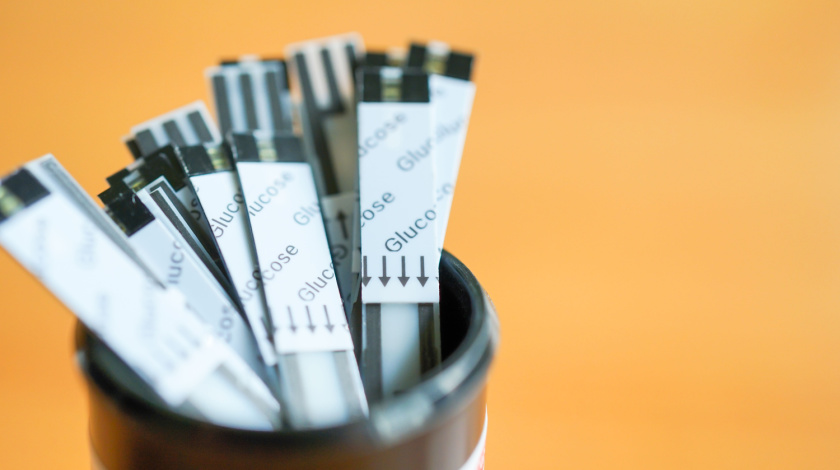It is not often you come across a medical device that changes the lives of people radically. A glucometer kit is one of them. Today, this device helps millions of people with diabetes manage their blood sugar levels from the comfort of their homes/workplaces. It not only reduces frequent visits to the lab but also allows the afflicted individuals to test even as they travel. The portability factor reduces the fear of blood glucose spikes and its lethal repercussions. Glucometer and glucometer test strips have revolutionised the way people across the world monitor their diabetes.

Interestingly, the history of test strips can be traced back to the early 1960s. It was an eventful period for Ernie Adams. He designed a paper strip, very similar to today’s sugar strips, which changed to a blue colour on reaction while its intensity depended on the glucose concentration. The final shade of this strip was then compared with a colour-concentration chart.
Since then, the test strips have evolved drastically.
Although test strips appear simple and nondescript, they are highly reactive in nature, and therefore, they are also called reactive strips.
Glucometer Strips 101- Understanding the Basics
A glucometer strip is incapable of providing blood sugar levels without a glucometer. Both play an important role in diabetes management. However, sugar check strips are the span, the bridge between the humans and the machine. When a drop of blood is released on a test strip, which is pre-soaked with an enzyme (glucose oxidase), it reacts with the glucose present in the blood and sends out a signal through a complex nano-circuitry printed on the strip itself. The glucometer then interprets these signals and converts them into numbers.
For the uninitiated or those who have been recently diagnosed as pre-diabetic or diabetic, you need to understand that the strips are a vital part of the glucose monitoring kit. Some of the other essential components of this kit include –
- Lancets / Lancing Pen
- Test Solution
- Calibration Chip (Optional)
Choosing the Right Glucometer Strips – Factors to Consider
Unlike nano-components of regular medical devices, which are interchangeable and therefore not brand or model limited, the digitally designed and enzymatic-based test strips are just the opposite. These strips are rigid when it comes to brand flexibility, and their core circuitry is “device model” sensitive, too. It is, therefore, imperative to buy strips that are compatible with your device.
If you are buying from an online store, make sure you read the list of brands that the strips are compatible with. Once you have narrowed down your choice and are satisfied with its performance and compatibility, stick to that particular product. Remember, changing the “glucose test strips” brand frequently isn’t suggested.
Opt for test strips which are trustworthy, have been around for a long time, and are easily available (online and offline). If your test routine is random/weekly/monthly, then you don’t need a large stock. In such a scenario, a test strip manufacturer who offers a wide range of packs (in terms of quantity) is the best option for you. There is no need to hoard because test strips lose their enzymatic activity over a period of time.
Accurate Testing Techniques – Using Glucometer Strips Effectively
At the very outset, you need to understand that the glucometer strips are highly sensitive and reactive, so you must prevent degradation. What does this mean, and as a person with diabetes, how can you achieve this? Mentioned below are some tips –
- Keep the test strips in a dry and cool place.
- Close the container immediately after the strip is extracted.
- Do not refrigerate / and or store in a humid environment.
Expiration –
Sugar machine strips are typically enzyme-soaked and then dehydrated. Over a period of time, especially as it approaches its expiry date, it may lose some of its reactive properties. This could lead to inaccurate results. Avoid using strips which are about to expire or have expired, even if it is a day or a week.
Some of the other steps you need to adhere to get accurate results include –
- Make sure your glucometer is functioning well and clean.
- Avoid touching the strip with wet, oily, fruit/food-stained fingers.
- Make sure you transfer enough blood (sample) on the strip.
Glucometer Strip Compatibility – Ensuring a Perfect Fit
Before discussing glucometer strip compatibility, let us first understand the structure of this essential constituent of the glucometer kit. A sugar strip is a rectangular plastic strip embedded with an electronic circuit (nanoparticle sensor), layered with capillary paper, and soaked in an enzyme, which is later dehydrated for a longer shelf life. It is this complexity and dimensional rigidity which makes strips incompatible with other sugar machines. Remember, printed circuit design may vary, the enzymatic value may vary, and even the dimensions of the strips may vary. Using incompatible strips forcibly will surely provide readings which are incorrect and lead to severe consequences. So, how do you ensure a perfect fit? Simple! Opt for glucometer strips which are brand and model complementing, irrespective of the glucometer strips’ price.
Troubleshooting Glucometer Strip Issues – Tips and Solutions
Although most of the time, the culprit for incorrect reading is the test strip, at times, the device may also be responsible. It is, therefore, a good idea to get the machine checked once in a while. As far as troubleshooting a faulty glucometer strip is concerned, mentioned below are some of the tips and solutions –
- If you feel that your readings have changed sharply over the last few tests, make sure your test strips haven’t expired or are close to the expiry date.
- Never use a chipped strip. You may get incorrect results due to inefficient capillary action or damaged circuitry.
- Always calibrate your new strip box before you initiate your first test.
Visit your nearest lab once in a while to confirm your glucometer readings, especially when there is a sharp deviation from the usual.
Incidentally, the difference between glucometer and lab test results is around 15%. In case your device/test strip reading difference is over 20%, it is a sign that something is wrong. Get your device checked and/or try a new pack of sugar check strips.
Read More: Glucometer Strips: Empowering Diabetes Management with Precise Blood Sugar Monitoring
Conclusion
Sugar test strips may seem ordinary and unimportant in appearance, but the fact remains that they play an important role in the lives of people with diabetes (type-1 and type-2). As far as compatibility is concerned, test strips can be quite demanding. It is important that you not only interpret the readings correctly, but you also need to be cautious while buying a new box of test strips. Remember, sugar strips’ price should be your least concern. What you do need to ascertain is that it should be compatible with your device. If all this seems overwhelming, simply visit the BeatO website, one of the most popular and innovative healthcare apps/ portals, to get all your medical essentials, such as devices, test strips, medicines, etc., in one place.
Disclaimer:The content of this article is compiled information from generic and public sources. It is in no way a substitute, suggestion, or advice for a qualified medical opinion. Always consult a specialist or your own doctor for more information. BeatoApp does not claim responsibility for this information .
Dr. Navneet Agarwal is an established and highly skilled Diabetology with over 25 years of experience in Diabetology & Obesity. He is well-regarded for his quality and patient-centered diabetes care. Also, keep track of your blood sugar levels with a Doctors’ approved smart glucometer and elevate your healthcare routine.




